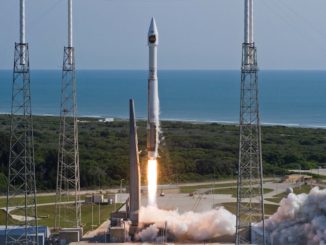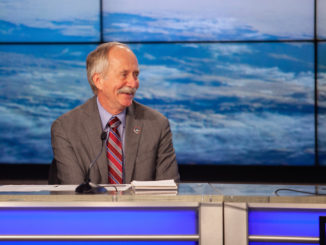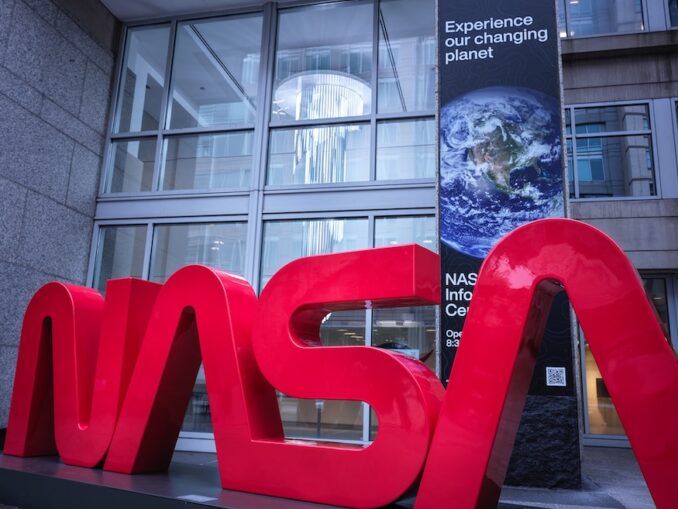
Update Oct. 1, 11 a.m. EDT (1500 UTC): Added new responses from NASA; update noting that the shutdown began on Oct. 1, 2025.
A new report from the Democratic staff of the U.S. Senate Committee on Commerce, Science, and Transportation (CST) argues that NASA has been “illegally” implementing President Donald Trump’s proposed budget request (PBR) and ignoring the funding levels previously approved by Congress.
The document, published on Sept. 29, is titled “The Destruction of NASA’s Mission: Whistleblowers Reveal OMB’s Unconstitutional Plot to Gut the Agency” and can be found by clicking here. The document was published by the committee on the eve of fiscal year 2025 (FY25) ending at 11:59 p.m. EDT on Sept. 30.
“Based on whistleblower documents and interviews, this staff report finds that the White House Office of Management and Budget (OMB) has been directing NASA — since early summer — to begin implementing the devastating cuts demanded in President Trump’s proposed budget for FY26, in clear violation of the Constitution and without regard for the impacts on NASA’s science missions and workforce.”
The document breaks down its research based on four “key findings” as it sees them:
- NASA Has Been Implementing the President’s Proposed Fiscal Year 2026 Budget Cuts Since Early Summer—In Clear Violation of the Constitution
- Culture of Fear and NASA Jeopardizes Safety and Security
- The Administration is Hiding OMB’s Budget Directives
- President’s Budget Cuts Will Kneecap the U.S. Innovation Economy
On Monday, Spaceflight Now reached out to NASA regarding a number of items raised by the report, but did not receive answers prior to publication. A NASA spokesperson noted that multiple members of leadership were traveling to and from Australia as part of this week’s International Astronautical Congress, which include Acting Administrator Sean Duffy who spoke at the conference on Monday (comments from Duffy begin about 4 hours and 38 minutes into the livestream) and held meetings with other nations’ space agency leaders.
On Wednesday, NASA Associate Administrator Amit Kshatriya flatly refuted the claims made by the CST Committee report and said, “The report is false.”
“NASA has communicated openly and transparently with Congress that we continue to execute our available appropriated funding in accordance with established fiscal policies which respect congressional authorities,” Kshatriya said in a statement to Spaceflight Now. “NASA will never compromise on safety. The President’s budget request stands with Congress at this point, and NASA will enact the budget appropriated to us.”
Packed day and packed house down at IAC in Sydney.
Today, I met with 38 other nations out of the 56 that have signed the Artemis Accords at our annual meeting.✍️📜
We spoke about how we’re working together to safely return man to the Moon.
Follow along for more, and GO… pic.twitter.com/wA3qOR8XKz
— NASA Acting Administrator Sean Duffy (@SecDuffyNASA) September 30, 2025
The PBR outlines a NASA budget of roughly $18.8 billion for FY26 as compared to $24.9 billion for FY24 and roughly the same for FY25. Following its publication back in May, it received strong condemnation from organizations, like The Planetary Society, a respected space advocacy non-profit; the Coalition for Deep Space Exploration, a national organization consisting of more than 65 space industry businesses and universities; and the American Institute of Aeronautics and Astronautics, a technical society focused on the aerospace profession since 1963.
These groups and others expressed especially deep concern for the 47 percent reduction in the science budget and other cuts as proposed by the PBR.
“Slashing NASA’s budget by this much, this quickly, without the input of a confirmed NASA Administrator or in response to a considered policy goal, won’t make the agency more efficient — it will cause chaos, waste the taxpayers’ investment, and undermine American leadership in space,” the Planetary Society argued.
However, the Senate CST Committee’s report argues that such action has been in motion since the summer. The report cites a NASA whistleblower who said that the agency’s chief of staff, Brian Hughes, “has been leading the effort to actively implement the PBR.”
“The whistleblower recounted how Mr. Hughes told agency employees earlier this year that NASA would begin implementing the President’s budget request, without any act of Congress, because it is supposedly the ‘responsible thing to do,’” the report stated.
Back in July, NASA Press Secretary Bethany Stevens pushed back against a similar claim in a statement to Ars Technica, in which she said, “This is either a misinterpretation or mischaracterization of Brian’s words.”
“Brian has issued no guidance stating that the PBR will become the operating plan for NASA prior to Congressional authorization of a budget,” Stevens told Ars.
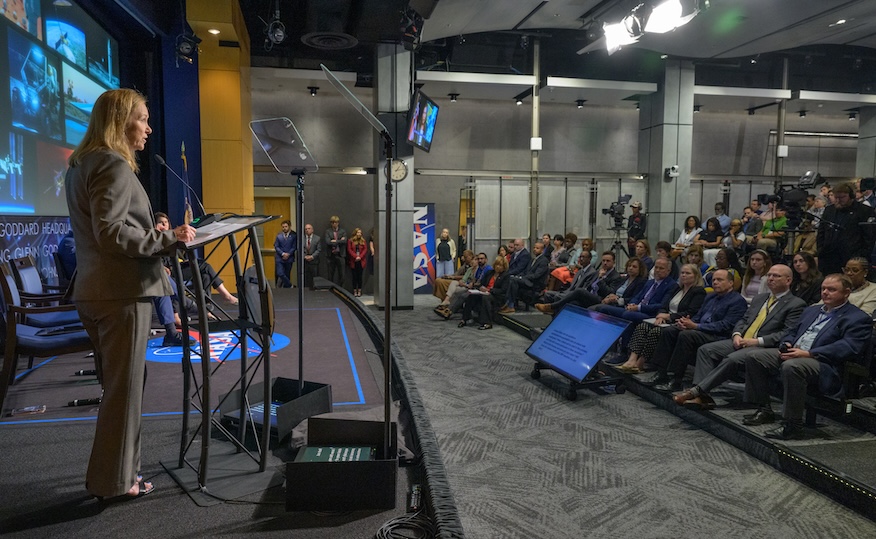
Beyond the recollection of this and other whistleblowers, the report also points to an email dated June 20, 2025, from then-Acting Administrator Janet Petro that reportedly directs the various parts of the workforce to start pivoting towards the President’s budget priorities ahead of a congressionally approved budget.
“Some have asked why we’re acting now, or whether we should wait to see how Congress acts,” Petro said in the email. “The reality is we must make responsible choices based on the funding we are projected to receive and begin shaping the workforce toward the missions we’ve been called to do.”
Petro also said something similar in a June 27 email, also cited in the report, in which she wrote in part:
“The President’s FY 2026 Budget Request for NASA is NASA’s budget request — and while it’s still working through Congress, we have to begin preparing to align our workforce and resources now to meet the mission priorities it outlines.”
NASA officials said that it is routine for FY26 execution guidance to be sent to the various NASA centers and mission directorates in order to try and not surpass anticipated funding from Congress. The agency is required per Section 505 of the Appropriations reporting requirements to give prior notification before enacting major reprogramming actions, like cancelling projects or large-scale layoffs, known as reductions-in-force (RIFs).
However, as these directives were reportedly being put into motion, according to the CST committee report, both the House of Representatives and the Senate were crafting their own appropriations bills that produced far less reductive changes to NASA’s budget.
On July 30, the American Astronautical Society published a comparison of the science allocation in the PBR and the proposed budgets from the relevant House and Senate committees:
- FY24 enacted – $7.3 billion
- PBR – $3.907 billion
- Senate – $7.3 billion
- House – $6 billion
The appropriations bill that would fund NASA was not signed into law prior to the shutdown going into effect on Oct. 1.
Impacts of a potential government shutdown
According to the Committee for a Responsible Federal Budget, a nonpartisan, non-profit focused on “educating the public on issues with significant fiscal policy impact,” there have been four “true” shutdowns since 1976 “where operations were affected for more than one business day.” The most recent of those was the shutdown from December 2018 through January 2019.
Like today’s looming work stoppage, that 35-day shutdown began under Republicans control of the House, the Senate and the White House.
In the event of any shutdown the CRFB noted that it’s up to each federal agency to create its own shutdown plan “following guidance released in previous shutdowns and coordinated by the Office of Management and Budget.” On Sept. 29, Steve Shinn, NASA’s Chief Financial Officer, sent a document titled NASA Continuity of Appropriations Plan to the OMB to fulfill this obligation.
On Monday, Sept. 22, ahead of the launch of NASA’s Interstellar Mapping and Acceleration Probe (IMAP) Spaceflight Now asked Dr. Nicky Fox, Associate Administrator of NASA’s Science Mission Directorate, about what level NASA’s science budget would be operating in the event of a government shutdown.
“In the event of a government shutdown, we will cease the work that the government has shut down. We will focus on making sure we maintain life and we maintain property,” Fox said. “So of course, any astronauts on the ISS, we’re taking care of them. Our missions in space that are operating, we’re very much taking care of them… Any other work that is not pertaining to life or property, we will stand down until the government tells us to come back, whether it’s under a continuing resolution or whether it’s under an appropriation.
“At that point, we’ll know the level that we’ll be operating, so we’ll either be given guidance in the event of a CR or we’ll be given an appropriation. So we look forward to getting that guidance and continuing to do the great science that we do at NASA Science.”

Because House Speaker Mike Johnson (LA-04) recessed the House until Oct. 7, and the Senate hasn’t reached the 60-vote threshold to override a filibuster by Senate Democrats, a shutdown seems likely. However, according to an email dated July 1, 2025, cited in the CST report, the intention of the Trump Administration is to enact the PBR funding levels regardless of whether a CR comes to bear.
“PBR is the direction. Discretionary funds can be impounded per the Impoundment Act of 1974,” said an email summarizing what it called a “leadership round table.”
“If there is a CR, impoundment is likely going to get on the table as a mechanism to get to the PBR.”
Earlier this month, Ars Technica reported that 19 active space missions, including two Orbiting Carbon Observatory missions, the Chandra X-ray Observatory and New Horizons, are on the chopping block, if the PBR is fully implemented.
Safety and economic output reductions
The CST report argues that not only will the PBR reduce economic output, but will also reduce safety at NASA.
It points to comments from NASA whistleblowers who said that they have “already seen safety impacts,” with one warning that they were “very concerned that we’re going to see an astronaut death within a few years” thanks to a “chainsaw approach” being taken by the administration.
“In addition to whistleblower reports on the broader culture shift away from proactive safety reporting, Committee indicating that NASA’s Ombuds Program—which was established 20 years ago as an independent, confidential and neutral communication channel to resolve safety and performance issues without fear of retaliation—has been by political leadership,” the report stated.
In a recent column published in The Space Review, former NASA astronaut Garrett Reisman said during a March 2025 trip to the Johnson Space Center he “found an environment of fear and uncertainty that struck me as a serious safety concern.”
“In the current environment of fear and uncertainty at NASA, it will be more challenging than ever to elicit dissenting views, making it more difficult than ever to prevent the next human spaceflight tragedy,” Reisman said.
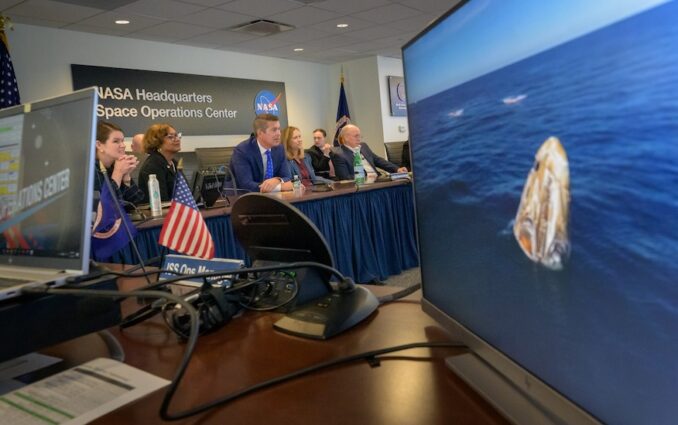
Reisman is also one of more than 360 current and former NASA employees who signed a letter in July to Duffy pushing back on the proposed PBR cuts, called the “The Voyager Declaration.”
“Major programmatic shifts at NASA must be implemented strategically so that risks are managed carefully,” The Voyager Declaration states. “Instead, the last six months have seen rapid and wasteful changes which have undermined our mission and caused catastrophic impacts on NASA’s workforce.
“We are compelled to speak up when our leadership prioritizes political momentum over human safety, scientific advancement, and efficient use of public resources. These cuts are arbitrary and have been enacted in defiance of congressional appropriations law. The consequences for the agency and the country alike are dire.”


